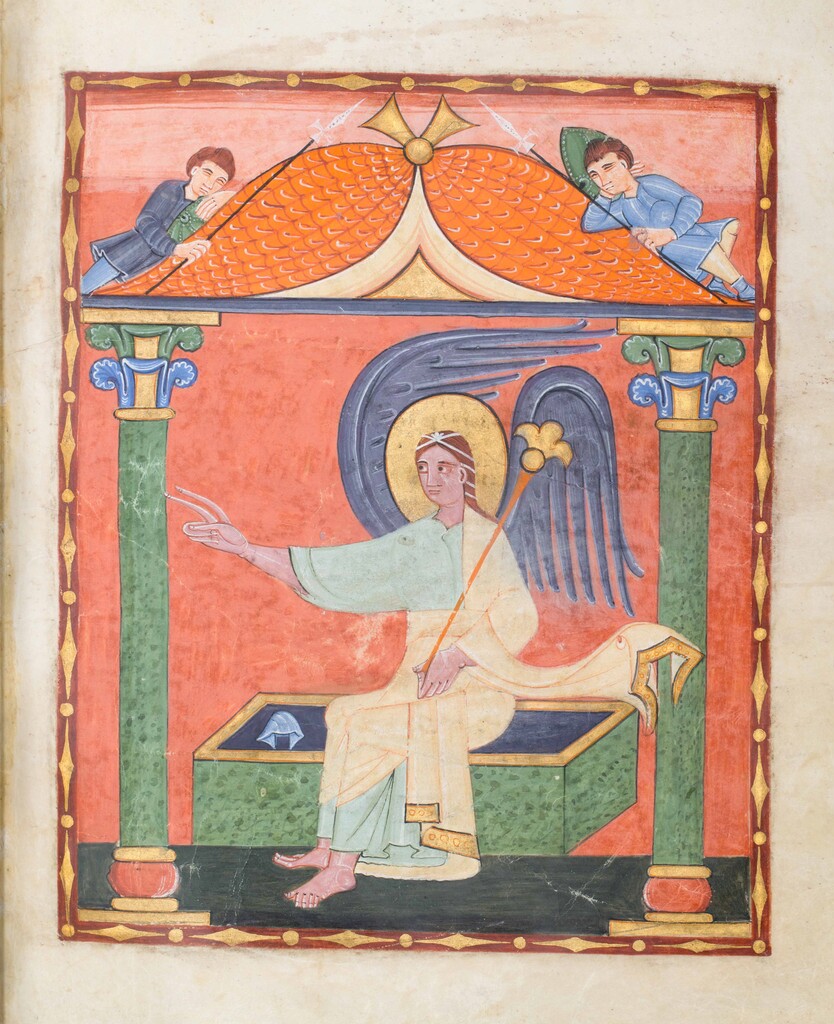Getty's German Manuscript Was a French National Treasure
 |
| The Angel at the Empty Tomb of Christ, Irmengard Codex, after 1053. Getty Museum. Image courtesy of Dr. Guenther Rare Books AG, Basel |
More details on the Getty's new manuscript purchase have emerged. Designated a French national treasure, the book's sale has led into finger-pointing in France over its "loss" to a foreign buyer.
The manuscript is a very rare Ottonian (German, 11th century) book with 15 full-page illuminations. The Getty has named it the Irmengard Codex, after the medieval noblewoman who commissioned it. When the acquisition was announced last week I did a Google search under that name and came up empty.
It turns out that the manuscript has an online presence under a different name. It's generally been known as the Saint-Mihiel Evangelary.
The book is presumed to have been created at the Benedictine Abbey of Reichenbau, on an island in a lake in southern Germany. For most of its history it has resided in northeastern France, however: at the Abbeys of St. Mansuy de Toul (Meurthe-et-Moselle) and then St. Michel de St. Mihiel (Meuse). In 1830 the manuscript turned up at book dealer's in Meuse. Charles Didiot, a future bishop, bought it and gave it to another clerical relation, Jules Didot. Jules donated it to the then-new Catholic University of Lille in 1881.
 |
| Catholic University of Lille |
In The Art Tribune, Didier Rykner faulted the Archdiocese of Lille for selling at market price rather than for pennies on the euro, to keep it in France: "Temple merchants are no longer outside the Church, they are now in the Church."
To put this in perspective, the BnF has about 145,000 manuscripts of all kinds (v. 200+ for the Getty), and the BnF's exhibits draw about 336,000 a year (v. 1,400,000 for the Getty, both 2019 figures). There's not much doubt that Irmengard's book will make a bigger impact at the Getty and be seen by more people.
 |
| Pre-conservation image of The Ascension of Christ |
 |
| The Ascension of Christ, Irmengard Codex, after 1053. Getty Museum. Image courtesy of Dr. Guenther Rare Books AG, Basel |
Comments
> (v. 200 for the Getty), and the BnF's exhibits draw
> about 336,000 a year (v. 1,400,000 for the Getty,
> both 2019 figures).
In the supply-and-demand equation, those two institutions are a** backwards.
Moreover, given the nature of Louvre World (in Paris, Florida---or maybe that should be Orlando, France?), much less things like the Musée d'Orsay (a relatively new arrival, dating back merely to the late 1970s), the German manuscript is just small potatoes. Not to mention that given all the politics or controversy surrounding something as basic as restoring fire-damaged Notre Dame, French authorities may not even care. Or can be trusted.
https://commons.m.wikimedia.org/wiki/Category:%C3%89vang%C3%A9liaire_de_Saint-Mihiel